The Friends of the Wildflower Garden, Inc.
Plants of the Eloise Butler Wildflower Garden
The oldest public wildflower garden in the United States
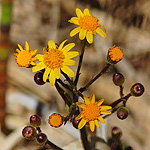
Common Name
Golden Ragwort (Heart-leaved Groundsel, Golden Groundsel, Squaw weed, Life root)
Scientific Name
Packera aurea (L.) A. Löve & D. Löve
Plant Family
Aster (Asteraceae)
Garden Location
Wetland
Prime Season
Late Spring Flowering
Ragworts have small flower heads on long stalks appearing in a branched terminal cluster. Golden Ragwort is an erect native perennial. The flower stem can be from 6 to 30 inches high, is usually hairless and has a dark purple color at the top.
Leaves: Golden Ragwort has a rosette of long-stalked basal leaves that are longer than wide, bluntly rounded with wavy lightly indented to crenate margins, heart shaped at the base often with a purplish color on the stalk. The stem leaves are alternate, lyrate to lance shaped with 2 to 4 pairs of lobes, with long stalks, and become progressively shorter, and then on the uppers they are without stalks (sessile), but not clasping.
The floral array is a somewhat flat-topped branched cluster of 6 to 20+ flower heads with each head stalked.
Flowers: The flower head is composite and consists of 55 to 70+ bisexual fertile disc florets with golden colored corolla tubes that are 3 to 3.5 mm long. Each floret has 5 stamens that tightly surround a single style which has a bifurcated tip, both stamens and style are exserted from the corolla when the floret opens. Disc florets are surrounded by 8 to 13 shiny yellow pistillate and fertile ray florets whose laminae are 8 to 10+ mm long and which are slightly reflexed; in all the flower head is 1/2 to 1.3 inches wide, slightly wider than long with the involucre cylindric. The phyllaries around the outside of the flower head number 13 to 21, are green with purple or black pointed tips. The calyculi (bract-like structures at the base of the flower head) are inconspicuous but there are very small bracts at the base of the flower cluster.
Seed: The cypselae (dry achene like seeds), are without hair, 1 to 1.5 mm long, with fluffy white pappus for wind distribution. Seeds are very small and need light plus at least 60 days of cold stratification for germination.
Habitat: Golden Ragwort grows from rhizomes in moist conditions of marshes and in moist woods and meadows in full sun to light shade. Full sun requires moist conditions.
Names: In older reference works Golden Ragwort was classified as Senecio aureus, the name assigned by Linnaeus in 1753. The genus Packera is now considered a segregate of Senecio. The name Packera is an honorary for Canadian plant systematist and contributor to Flora of North America, John Packer. The species aurea is Latin for "golden".The older common names containing the word 'groundsel', according to Mrs. Grieve (Ref. #7) go back to Anglo-Saxon times and were derived from groundeswelge which meant 'ground-swallower' which referred to the rapid way in which some plants of the genus Senecio could spread.
The author names for the plant classification are: First to classify was '(L.)' which refers to Carl Linnaeus (1707-1778), Swedish botanist and the developer of the binomial nomenclature of modern taxonomy. His work was updated in 1976 by 'A. Löve & D. Löve' which refers to Áskell Löve (1916-1994) Icelandic botanist, cofounder of the Flora-Europaea project and professor at various universities in North America and Doris Löve (1918-2000), Swedish systematic botanist, active in the Arctic and collaborator with Áskell Löve on numerous publications.
Comparisons: Another similar ragwort is Prairie Ragwort, Packera plattensis, where the flowers are more yellow, the stems and leaves have hair and it prefers less moist soils. Read Eloise Butler's notes below.


Above: The floral array is a branched cluster of stalked flower heads. Note the much reduced upper stem leaf. Drawing ©USDA-NRCS Plants Database.
Below: 1st photo - The outer ray florets surround a flatish central disc of numerous disc florets. 2nd photo - The phyllaries of the flower head are green with spreading purple tips. The small calyculi at the base of the phyllaries are inconspicuous.


Below: 1st photo - A basal leaf. 2nd photo - The flower clusters have very small purple tipped bracts at the base of the cluster.
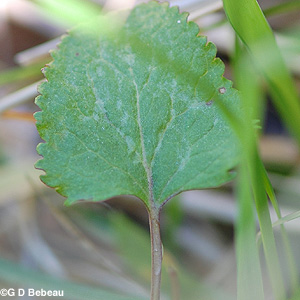
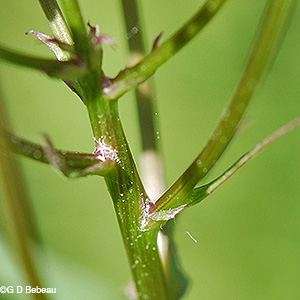
Below: Two views of the lower stem leaves, which are stalked with 2 to 4 pairs of lateral lobes. These are much reduced toward the top of the stem as seen in the photo above.
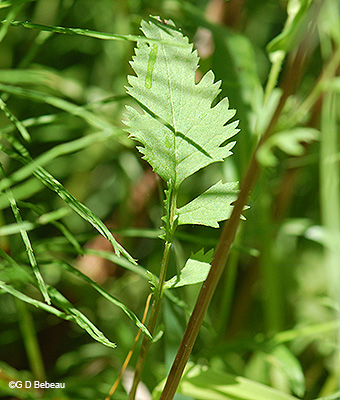
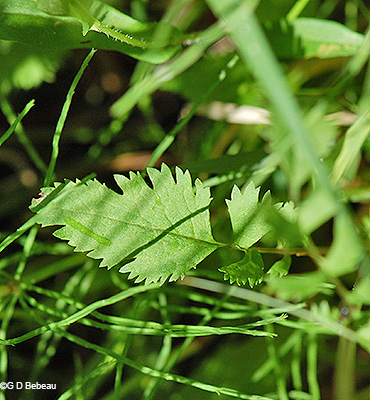
Notes: Golden Ragwart is listed on Eloise Butler's tally of indigenous plants of the Garden area. She first noted it in bloom on June 3, 1908. She planted it in 1927. Martha Crone noted planting it in June 1945 and in 1946, '48, and '50. She listed it on her 1951 Garden census. It is native to many counties in Minnesota, principally in the northern 2/3rds of the state and in SE corner. In North America it is found in the eastern half of the continent. It is one of six species of Packera in the state and is one of the three most common along with P. plattensis (Prairie Ragwort) and P. paupercula (Balsam Ragwort).
Eloise Butler wrote: "In the meadows may also be seen an early composite, the Golden Ragwort. In the composite family [now called the Aster Family] what seems to be a flower, at a careless glance, is in reality a flower cluster, composed of small closely crowded flowers, with buds or tubular flowers in the center that might be mistaken for stamens and pistils, and surrounded on the outside by whorls of green leaves called bracts that exactly imitate a calyx. The foliage of the ragwort is more or less cut or parted, hence the name." Published May 28, 1911, Sunday Minneapolis Tribune.
Medicinal Lore: There is literature on the use of the flowers and the root for medicinal purposes. A tincture of the fresh flower was used for many ailments. The root in powdered form made into a liquid extract was used to treat women's gynecological disorders and also for treating consumption. Details in Hutchins (Ref. #12) and Grieve (Ref. #7). The active principles are Pyrrolizidine alkaloids. The plant has little odor but a bitter taste. Mrs. Grieve writes that the plant "has often been used in the first stage of consumption for the beneficial effects of its tonic properties."
Return to -- Site Plan/Archive Index --or-- List of Common Plant Names -- or -- List of Scientific Names -- or --Home Page - - - Back to top.
References: Plant characteristics are generally from sources 1A, 32, W2, W3, W7 & W8 plus others as specifically applied. Distribution principally from W1, W2 and 28C. Planting history generally from 1, 4 & 4a. Other sources by specific reference. See Reference List for details.
 Identification booklet for most of the flowering forbs and small flowering shrubs of the Eloise Butler Wildflower Garden. Details Here.
Identification booklet for most of the flowering forbs and small flowering shrubs of the Eloise Butler Wildflower Garden. Details Here.
©2013
Friends of the Wildflower Garden, Inc. Text and photos are by G. D. Bebeau unless otherwise credited. "www.friendsofeloisebutler.org"
071320